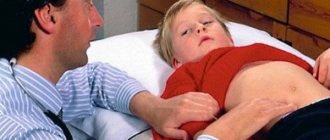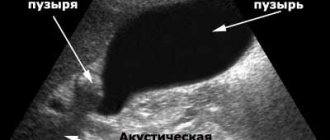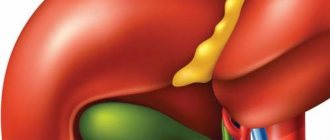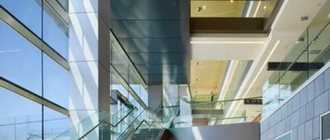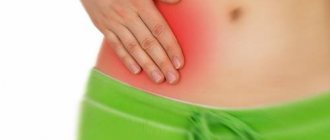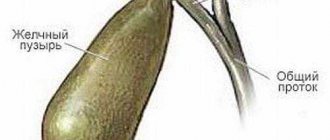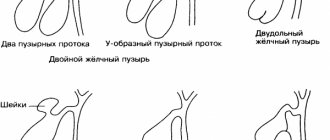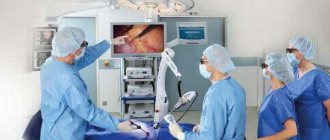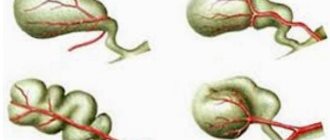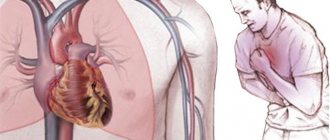Features of the structure of the gallbladder
The external gallbladder resembles a sac-like oval formation of an elongated shape with one wide end and the other narrow end. The width of the organ decreases from the bottom to the neck, where the cystic bile duct begins to pass. At the porta hepatis, it enters the hepatic duct, and together with it forms the common bile duct, which unites with the pancreatic duct. It passes through the sphincter of Oddi into the duodenum.
The length of the gallbladder in adults reaches 8-10 cm. The width of the walls of the organ is 3-5 cm, but it can change due to stagnation of bile, overstretching of the walls with stones and the action of a chronic inflammatory process.
Anatomy and location of the organ
The gallbladder is shaped like a pear and is located on the visceral surface of the liver in a special depression that separates the two lobes of the liver. In the anatomy of the gallbladder, there are three sections: the bottom, the body, and the neck. The bottom of the organ is located near the lower edge of the liver, and the neck faces the gate of the gland and is located together with the ducts in the duplication of the hepatoduodenal ligament.
In the area where the body meets the neck, a bend is formed, so the neck lies at an angle to the body. Between the transition to the cystic duct there is a depression called Hartmann's pouch. The normal size of the gallbladder in adults is: length 8–14 cm, width 3–5 cm. The organ holds 60–100 ml of liver secretion. In children, normal organ sizes are in an even larger range.
So, in a child 2–5 years old, the gall bladder is 3–5.2 cm long and 1.4–2.3 cm wide, and in a teenager it is 3.8–8 cm long and 1.3–2.8 cm wide. If the organ is larger, then this indicates obstruction of the bile ducts or acute cholecystitis. A decrease in size occurs with viral hepatitis (liver inflammation) or chronic cholecystitis. The organ wall includes the mucous membrane, muscular, subserous and serous layers. The mucous tissue is sensitive to adverse events occurring in the body, which is why it looks swollen and flaky.
Bundles of muscle fibers are located in the longitudinal and circular directions. There are gaps between them, and then in these places the mucous tissue connects with the serous tissue. This structure of the gallbladder increases the risk of bile leaking into the abdominal cavity (peritonitis) without compromising the integrity of the organ. There is less muscle tissue in the bottom area, and more in the neck area.
The photo shows the location of the organ relative to the liver
The blood supply to the organ occurs through the cystic artery, which comes from the right branch of the hepatic artery and at the neck of the bladder divides into two branches, one of them goes to the upper surface of the bladder, and the other to the lower. Lymph nodes are located to the left of the bladder neck and near the duodenum. When the bladder becomes inflamed, the nodes enlarge and block the common bile duct.
The innervation of the biliary system comes from the celiac, inferior phrenic plexuses and the anterior trunk of the vagus nerve. This means that diseases of the stomach, small intestine or irritation of the vagus nerve (which happens with a diaphragmatic hernia) can provoke malfunction of the sphincter of Oddi and inflammatory disorders in the bladder itself, and vice versa.
Patients often ask which side the gallbladder is on. The gallbladder is located on the right side of the body, under the ribs. In front of the gallbladder is the liver, on the left side is the pylorus, and on the right are the loops of the small intestine.
The bottom of the bladder, as a rule, extends from under the lower edge of the liver closest to the peritoneum by 2–3 cm and touches the anterior abdominal wall. This arrangement of the gallbladder and its ducts gives a projection of pain to the right hypochondrium and epigastric region.
Functions of the gallbladder
Main functions of the gallbladder:
- accumulation and concentration of bile;
- participation in the digestive process;
- protection of the gastrointestinal tract from infectious pathogens;
- timely entry of the required amount of bile into the duodenum.
The liver constantly secretes bile and it is stored in the gallbladder. When food enters the stomach, complex biochemical processes are launched. The gallbladder contracts and releases a portion of bile into the duodenum, where it begins to directly participate in the digestive process. With increased fat content of foods, the organ begins to contract more intensely in order to secrete more secretions.
Bile contains special pigments, acids, phospholipids, trace elements and substances with antimicrobial activity. It is the protective function of the gallbladder that prevents the occurrence of infectious and inflammatory processes in other organs of the digestive system.
Organ function
The function of the gallbladder in the human body is to store bile, which comes continuously from the liver. Here the liver secretion settles, becomes more concentrated, and then, when food enters the digestive tract, it is reflexively released into the duodenum.
A person can live a full life without a bladder, then the question arises why a gallbladder is needed. The fact is that the liver constantly produces bile; the secretion enters the bladder through the ducts, where it lingers for several hours (until food arrives). Liver bile is golden yellow in color, its pH ranges from 7.3–8, and its relative density is 1.008–1.015.
In the gallbladder, bicarbonates are absorbed, due to which the pH level decreases to 6–7, and the density increases to 1.026–1.048, which means that such a secretion will better perform its tasks: stimulate the functioning of the intestines, pancreas, have a bacteriostatic effect, break down fats , promote the absorption of water-insoluble fatty acids, cholesterol, vitamins, neutralize pepsin and create conditions for the activation of pancreatic juice enzymes.
If the gallbladder is not functioning well, a cholecystectomy (removal) is performed. In this case, the liver secretion constantly enters the duodenum and, in the absence of food there, begins to affect the intestinal tissue. Since bile stimulates the secretion of pancreatic juice and gastric mucus, their production is also disrupted.
In the absence of a gallbladder, the digestion process slows down, and hence flatulence, dysbacteriosis, colitis, enteritis, and reflux.
Causes of gallbladder diseases
The gallbladder is constantly influenced by external and internal factors, including the nature of a person’s diet, stress, concomitant diseases, and level of physical activity. And for a long time a person may not be aware of the pathology. The main reason for the development of most gallbladder diseases is the formation of stones.
Stones cause an inflammatory process, provoke stagnation of bile, proliferation of infectious pathogens, blockage of ducts, and the development of dangerous diseases that require surgical treatment.
Factors that provoke dysfunction of the gallbladder and the development of diseases:
- stagnation of bile against the background of long intervals between meals, the formation of stones and the development of a chronic inflammatory process, increased concentration of bile secretion;
- non-compliance with the principles of rational nutrition, frequent consumption of fatty, fried foods, alcohol;
- toxic effects of medications, external environmental factors, unfavorable working conditions;
- infection entering the gallbladder with blood flow from other affected organs, active proliferation of pathogenic microorganisms due to prolonged stagnation of bile;
- formation of cysts, benign and malignant tumors;
- parasitic infections.
Gallbladder diseases are characterized by a long asymptomatic course. And only years later may characteristic signs appear that indicate stagnation of bile and blockage of the bile ducts with stones.
Is it possible to live without a bubble?
For those who are undergoing surgery to remove this organ, the question of its purpose is one of the most important. Two opposing points of view are identified:
- modern man does not need it, the supply of secretion is not important in conditions of normal nutrition;
- the organ is necessary, we just don’t know all the functions of the gallbladder, we need to resist removal as long as possible.
The right decision would be to preserve and treat an organ that has not lost its ability to accumulate, process and expel bile, ensuring natural digestion.
Why do we need a gallbladder after the accumulation of stones in it, inflammation with the release of pus, because it becomes dangerous to health? To save the life of the patient, it should be removed; in case of removal, its replacements will be ducts. They have the ability to stretch, accumulating the required volume of secretion, and concentrating it. With prolonged stone disease, the body itself gradually excludes the gallbladder from digestion, which makes it a low-functioning organ at the time of surgery.
Symptoms of gallbladder dysfunction
The main symptom of gallbladder disease is acute or dull aching pain in the right hypochondrium. It occurs with calculous cholecystitis, and with non-calculous cholecystitis, and with the formation of cysts and tumors. Depending on the intensity of the pain syndrome, a person decides whether to seek help from professionals or not. But there is no need to wait for signs of acute biliary colic, which can result in serious complications, including perforation of the bladder walls. As soon as pain appears in the right hypochondrium, make an appointment with a gastroenterologist or therapist and undergo a series of laboratory and instrumental tests.
Additional symptoms of gallbladder disease:
- nausea and vomiting;
- belching with bitterness;
- disturbance of stool, but more often - diarrhea, discoloration of stool;
- bloating;
- yellowing of the skin and mucous membranes;
- darkening of urine;
- small rashes on the body.
Signs of biliary colic
Many people are not even aware of the presence of stones until symptoms of biliary colic appear. A person experiences acute pain in the right hypochondrium and epigastrium, which can radiate under the shoulder blade, into the neck and lower back. Fatty or spicy foods and alcohol consumption provoke attacks.
In some people, biliary colic develops after excessive physical exertion and severe stress. If a stone gets stuck in the bile duct, obstructive jaundice appears, the stool becomes discolored, and the urine darkens.
Features of pain syndrome
The gallbladder hurts if inflammatory or degenerative processes occur in it. Most often, pathological processes develop as a result of blockage of the biliary tract with a stone or due to dyskinesia. Because the gallbladder hurts, one can assume a pathology. Against the background of pathological conditions, biliary (hepatic) colic occurs, which is characterized by severe pain.
With biliary colic, pain often appears against a background of complete calm. It is felt on the right under the ribs in the area of the projection of the gallbladder, less often in the upper abdomen.
The pain syndrome spreads to the area of the right shoulder blade, collarbone, neck, and shoulder. In some situations, pain is felt in the area of the heart and the person thinks it is an angina attack. The pain is described as cutting, stabbing, tearing.
An attack of hepatic colic is usually accompanied by nausea, vomiting of bile (it is not abundant and does not bring relief), and flatulence. Palpation reveals tension in the muscles of the anterior abdominal wall. If vomiting is continuous, this indicates involvement of the pancreas in the pathological process.
Pain in the biliary tract lasts from a quarter of an hour to 60 minutes
If the pain persists longer, then this is a sign of complications. This is also indicated by an increase in temperature above 38 0C. As a rule, colic occurs after eating spicy, fatty, heavy foods. Colic does not appear out of nowhere; patients indicate that they previously had pain in the right hypochondrium of varying duration and intensity. As the pathology develops, episodes of biliary colic become more frequent and their intensity increases.
Cholecystitis
In chronic or acute cholecystitis, constant aching or sharp pain is felt in the area of the gallbladder. The pain can radiate to the right shoulder blade, shoulder, neck, and less often the pain syndrome spreads to the left half of the body. Biliary colic usually appears after drinking alcohol, fatty or spicy foods, or severe stress.
Sometimes patients complain of a metallic taste or bitterness in the mouth, belching, flatulence, nausea, bowel dysfunction, insomnia or irritability, low-grade fever. Acute cholecystitis, with a mild course, can proceed quickly (5–10 days) and end in recovery. If an infectious agent enters the body, the disease can develop into purulent cholecystitis. This is dangerous and may have nonspecific manifestations.
The pain syndrome with purulent cholecystitis is very pronounced, determined in the right half of the abdomen, but can spread to the right shoulder blade and shoulder.
During the episode, the patient assumes a forced body position (“fetal position”), turns pale, and sweats profusely. In addition, body temperature rises, chills and tachycardia occur. Usually, with the disease, other symptoms appear that indicate damage to the abdominal cavity (flatulence, nausea, vomiting of bile, heaviness in the abdomen).
Since the organs of the human digestive system are interconnected, inflammation from one often spreads to others. For example, cholecystitis can cause the development of pancreatitis and gastritis, and vice versa. The fact is that the ducts from the pancreas and biliary system open into the duodenum and, if there are disturbances, pancreatic juice can penetrate into the bladder, which causes a strong inflammatory reaction.
When the gallbladder becomes inflamed, biliary function is impaired
Cholelithiasis
Stones can be cholesterol, calcium or bilirubin. Cholesterol is in a bound state, but if there are not enough binding bile acids, it precipitates. At first, small stones form, but gradually they increase in size, and under certain conditions they can clog the bile ducts.
In this case, bile does not penetrate the duodenum, the pressure in the bladder begins to increase, the stones injure the mucous membrane, which is why the gallbladder hurts. In developed countries, gallstone disease is diagnosed in a third of women and a quarter of men. The symptoms of gallstone disease depend on the location of the stones and their size.
So, if the stone is located at the bottom or in the area of the body of the organ and there is no inflammation, then there is no pain. If the stone is located close to the neck, then moderate pain occurs. If the calculus reaches the ducts, then a severe attack occurs, since the outflow of bile is disrupted, spasm and ischemia of the wall occurs. The sections of the ducts that are located above are greatly stretched when the stone moves, which causes increased peristalsis, so the pain does not stop until the stone reaches the intestines.
When cholelithiasis occurs, biliary colic occurs, which is characterized by severe, acute, sudden pain under the right rib. The nature of the pain is cutting or stabbing. After a few hours, the pain concentrates in the area where the gallbladder is projected. The cause of the pain is a spasm of the gallbladder muscles.
When the bile duct is completely blocked, the liver ducts expand, the organ enlarges, which causes a pain reaction in the overstretched capsule. Such pain is constant and dull in nature and is often accompanied by a feeling of heaviness in the right hypochondrium.
Common gallbladder diseases
There are many diseases of the gallbladder, but the most common are the following:
- gallbladder dyskinesia;
- cholecystitis;
- cholelithiasis;
- gallbladder cancer.
Gallbladder dyskinesia
With dyskinesia of the gallbladder, the contractility of the organ is impaired and the outflow of bile worsens. The disease progresses more often in women. Primary dyskinesia occurs with a congenital disorder of the motor activity of the gallbladder and a decrease in the sensitivity of its cells to hormonal mediators. Secondary dyskinesia is the result of hormonal treatment, the development of concomitant diseases and pathology of the biliary tract, including cholelithiasis and cholecystitis.
Most often, the disease develops due to high pressure in the biliary tract in combination with reduced activity of the bladder walls. In this case, the organ does not empty on time, bile enters the duodenum in limited quantities, which provokes chronic digestive disorders.
The main symptoms of gallbladder dyskinesia:
- constant dull pain in the right hypochondrium, not associated with eating;
- pain increases with changes in body position, when intra-abdominal pressure increases and bile outflow worsens;
- nausea and vomiting;
- slight discoloration of the skin yellow;
- a feeling of bitterness in the mouth;
- increased sweating;
- the appearance of rich colored urine.
To treat gallbladder dyskinesia, prokinetics, antispasmodics, and nonsteroidal anti-inflammatory drugs are used. It is possible to prescribe bile-containing drugs. The main emphasis is on diet. It is worth limiting foods that excessively contract the gallbladder: fats, fried, smoked and spicy foods, alcohol. Additionally, it is recommended to normalize weight and avoid excessive physical activity.
Cholecystitis
Cholecystitis is an inflammation of the gallbladder, which most often occurs against the background of the formation of stones. The disease occurs in middle-aged and elderly people, mainly in women.
Against the background of stagnation of bile, favorable conditions are created for the proliferation of pathogenic microorganisms. They can enter through the blood and lymph from other sites of infection or from the intestines. Most often, the inflammatory process is caused by staphylococci, streptococci, E. coli, protozoa and parasites.
Violation of the outflow of bile is provoked by diseases such as cholelithiasis, biliary dyskinesia, congenital or acquired anomalies of the gallbladder. Predispose to the development of cholecystitis is a violation of the diet, frequent alcohol consumption, a sedentary lifestyle, and large gaps between meals.
The main symptoms of the inflammatory process in the gallbladder:
- paroxysmal pain in the right hypochondrium and abdomen;
- weakness;
- increased sweating;
- nausea, vomiting mixed with bile;
- diarrhea;
- pronounced flatulence;
- feeling of bitterness in the mouth;
- chills, slight increase in body temperature;
- yellowness and itching of the skin.
Like other gallbladder diseases, cholecystitis requires diet. Nutrition should be as gentle as possible on the mucous membrane of the digestive tract. It is recommended to eat 5-6 times a day, but in small portions. Alcohol in any form, fatty meats and fish, smoked meats, seasonings, marinades, spices, sauces, mushrooms, and legumes are prohibited.
Drug therapy includes the prescription of painkillers and antispasmodics. If cholecystitis is infectious, antibiotics are prescribed. Additionally, experts recommend using drugs that stimulate bile formation (choleretics) or accelerate the outflow of bile (cholekinetics). But such remedies are prescribed only by a doctor who knows the nature of the disease and the condition of the gallbladder.
For the calculous form of cholecystitis, surgical treatment is used - open or laparoscopic cholecystectomy.
Cholelithiasis
Gallstone disease is accompanied by the formation of stones in the gallbladder and ducts. The pathology is based on the deposition of pigments, proteins, and calcium salts as a result of lipid metabolism disorders and constant stagnation of bile.
The experience of specialists has shown that drug therapy for calculous cholecystitis and other complications of cholelithiasis is ineffective. The only correct decision is to perform the operation in a timely manner. Otherwise, dangerous complications may occur, including perforation of the gallbladder wall.
The main symptoms of cholelithiasis:
- acute cutting pain in the right hypochondrium, which appears after consuming prohibited foods and drinks;
- nausea and vomiting (occur reflexively in response to irritation of the peripapillary zone of the duodenum);
- traces of bile may be present in the vomit;
- increased body temperature;
- when the sphincter of Oddi and the common bile duct are blocked, obstructive jaundice occurs, stool becomes discolored, and urine may darken.
Pain syndrome in gallstone disease occurs as a result of spasm of the muscles of the gallbladder and its ducts in response to the irritating effect of stones and overstretching of the walls of the organ. In case of exacerbation, a person needs immediate medical attention.
Drug treatment for gallstones is ineffective. It only allows you to slow down the development of the disease. Even after destruction of stones during shock wave lithotripsy or laparoscopy, the risk of their re-formation is very high. Therefore, experts recommend cholecystectomy before complications and severe disturbances in the functioning of the digestive system occur.
Watch this video about one of the common gallbladder diseases in which stones form.
Gallbladder cancer
Malignant tumors may appear in the gallbladder - adenocarcinoma or squamous cell neoplasms. They account for 5-10% of all cancerous diseases of the gastrointestinal tract. The tumor process is more often found in women over 50 years of age. In 80% of cases, specialists identify adenocarcinoma, which can grow in the fundus or neck of the gallbladder. Cancer often metastasizes to regional lymph nodes, peritoneum, ovaries and liver.
The main cause of a malignant tumor of the gallbladder is a long course of cholelithiasis or chronic cholecystitis. Most often, the tumor develops in an organ clogged with stones. Stones constantly damage the mucous membrane of the gallbladder, provoking malignant tissue degeneration.
Main symptoms of gallbladder cancer:
- weakness;
- constant dull pain in the hypochondrium, which people with gallstone disease get used to ignoring;
- weight loss;
- low-grade fever;
- yellowing of the skin and mucous membranes;
- constant nausea, possible vomiting;
- skin itching;
- lightening of stool and darkening of urine.
For a long time, gallbladder cancer occurs without significant symptoms. Often the disease is discovered accidentally during histology during cholecystectomy or against the background of calculous cholecystitis.
If you seek medical help early and perform an open cholecystectomy, the prognosis for the disease is favorable. But in most cases the disease is detected at a late stage, when distant metastases are actively spreading and it is not possible to manage only with radical removal of the tumor.
Biliary dyskinesia
“My gallbladder hurts. What to do?" - This question is very often asked to gastroenterologists. After all, tolerating the symptoms that accompany this deviation is not only impossible, but also dangerous to health.
Biliary dyskinesia is a disease of the digestive organ, which is characterized by a violation of its motor activity. As a result of this deviation, the process of bile entering the duodenum may be disrupted. In medical practice, there are two main types of presented pathology:
- hypotonic, that is, the motor activity of the organ is significantly reduced;
- hypertonic, that is, motor activity is increased.
To identify such a deviation, you should definitely contact a therapist and tell him about how your gallbladder hurts. Symptoms of this disease may appear as follows:
- With the hypotonic type - dull and aching pain in the area of the right hypochondrium, as well as a feeling of fullness. In addition, the patient may experience loss of appetite, belching, bitterness in the mouth, nausea and bloating. If a functional disease of the biliary tract is not treated in time, this can lead to the formation of stones in the bladder.
- With the hypertensive type - acute, brief and paroxysmal pain in the area of the right hypochondrium. Quite often, such sensations are associated with excessive physical exertion, as well as eating excessively fatty foods.
How to cure a gallbladder
Treatment for the gallbladder is selected by a gastroenterologist or therapist based on laboratory and instrumental diagnostic data. In this case, the age of the patient is taken into account. As a rule, the basis of most gallbladder pathologies is a chronic inflammatory process against the background of cholelithiasis. Therefore, the main method of treatment is removal of stones or the affected organ.
At an intermediate stage, during preparation for surgery or when providing first aid to a person with symptoms of biliary colic, the following groups of drugs may be prescribed:
- antispasmodics, analgesics;
- anti-inflammatory drugs;
- choleretic agents, choleretics and cholekinetics;
- hepatoprotectors;
- multivitamin complexes;
- preparations with acids that can have a destructive effect on stones.
Treatment of the gallbladder necessarily includes adherence to a therapeutic diet (table No. 5). The number of exacerbations of the underlying disease per year largely depends on this. If your doctor recommends surgery, you should not refuse it. Specialists are aware of severe cases of complications, due to which people end up in intensive care, and the surgeon still has to urgently perform cholecystectomy.
The superfood your gallbladder needs is flax seeds.
They improve the functioning of the digestive system, remove all toxins and bad bile from our body. When we don't get enough fiber, these unwanted substances can build up. Sluggish bile flow, in particular, can cause a variety of symptoms, including bloating and frequent constipation. The daily fiber intake for women is 25 grams, while for men it is 38 grams. Flax seeds can be safely added to cocktails and many dishes.
Indications for surgical treatment
Gallstone disease and chronic cholecystitis are accompanied not only by the formation of stones, but also by an irreversible impairment of the functional abilities of the gallbladder. The organ ceases to perform its main job, and there is no point in preserving it, since impaired functions can trigger a chain of additional diseases of the gastrointestinal tract.
The main indication for cholecystectomy is the presence of stones. The operation can be carried out planned or emergency, be open (with dissection of the anterior abdominal wall) or laparoscopic (the surgeon removes the organ through 4 punctures). Laparoscopy of the gallbladder is preferable to laparotomy. The operation using microsurgical instruments and endoscopic equipment is easier to understand, and it does not require long-term recovery.
An emergency open cholecystectomy can be performed if there is a risk of developing dangerous complications, including peritonitis and the risk of perforation of the gallbladder walls.
Sauerkraut is not only tasty, but also healthy!
We have heard a lot about how important it is to maintain normal intestinal microflora. After all, when bad bacteria overwhelm large numbers of good bacteria, it can cause a variety of symptoms, including some that affect the gallbladder. The correct balance of bacteria in the intestines reduces the risk of gallstones and relieves pressure on the organ. Probiotic foods, including fermented foods such as cucumbers, sauerkraut, and kombucha, can help restore this balance and play a role in a healthy diet. While you might think that yogurt is a good source of probiotics, it is actually not considered to be as beneficial for the gallbladder. Yogurt with active bifidobacteria can irritate the stomach, so it is best to avoid dairy products for your health.
As you can see, all of these products are available and available in any store. Therefore, it will not be difficult to take care of your gallbladder!
Nutrition for gallbladder health
Gallbladder diseases are chronic. The process of bile secretion is influenced by the degree of fat content of foods and many other food features. With pathologies of the gallbladder, it is very harmful to eat rarely, taking long intervals between meals. In this case, the bile constantly stagnates, irritates the walls and creates conditions for the formation of stones.
It is recommended to eat at regular intervals, preferably at the same time. It is necessary to exclude all potentially dangerous and prohibited foods, alcohol, carbonated drinks, and sour juices from the diet. The diet should be especially strict during the period of exacerbation of the disease. On the first day after the development of biliary colic, it is forbidden to eat, and you can only drink a decoction of chamomile, rose hips or still mineral water.
Avocado improves gallbladder function
When it comes to potassium-rich foods, avocados take pride of place. It's a superfood that's loaded with healthy fats and very high in potassium. The latter is an important nutrient for fluid and electrolyte balance, promoting excellent hydration. Most of us are chronically dehydrated, which leads to a number of health problems, including gallstones.
Stones form when bile is too thick, so hydration helps keep it at the right consistency to prevent unwanted deposits from forming. Bile stones can also form if it contains too much cholesterol, too much bilirubin, or not enough bile salts. You can reduce the risks by having an avocado salad for breakfast, or you can make avocado toast for a regular snack.
Prevention of gallbladder diseases
Even if you don't have gallbladder disease, you can reduce your risk of developing it by following a healthy diet. Limit spicy, fatty, spicy foods, sauces and mayonnaise, and smoked foods. Do not consume fast food or alcohol, try to exercise regularly and lead an active lifestyle.
Prevention of the occurrence of gallbladder diseases necessarily includes preventive examinations of the organ, especially with unfavorable heredity. If among your close relatives there are people who suffer from cholecystitis or cholelithiasis, do not be lazy to regularly undergo ultrasound diagnostics. And if stones are detected, agree to surgical treatment.
Watch conversations about the gallbladder with Professor Neumyvakin.
Which doctor treats the gallbladder?
Friends! Free healthcare in our country has not yet been abolished, so if you experience discomfort accompanied by bitterness in the mouth, pain in the right hypochondrium, constipation or diarrhea, you need to contact your local physician.
Any general practitioner is well acquainted with diseases of the digestive system. He will correctly assess your complaints, objective data, and conduct an examination. You will need to take blood tests, stool tests, and you will be prescribed an ultrasound. This will be followed by treatment, most likely with medications.
I would advise all patients to strictly follow the doctor's instructions. In addition to this, review your diet and eliminate things that are harmful to the liver. It is necessary that healthy foods prevail in the diet. Plus, periodically resort to the help of herbs, which we will talk about at the end of the article.
It is quite possible that these measures will be enough and your complaints will stop.
If discomfort continues despite you following all the instructions, your primary care physician may refer you to a gastroenterologist for consultation.
If for some reason you do not want to be treated in a clinic, then you have the opportunity to go to paid specialized medical centers where gastroenterologists conduct appointments.
In any case, the gastroenterologist can conduct a more in-depth examination, adding duodenal intubation or a number of other medical procedures. The doctor decides this issue. It all depends on the specific complaints and objective data that he has.
There is another specialist who deals with liver problems - a hepatologist. People with suspected hepatitis or those who have already had this disease, as well as people with cholelithiasis, turn to him to decide on the choice of treatment tactics: conservative or surgical.
If surgical treatment is required according to the conclusion of a gastroenterologist or hepatologist, then you are admitted to the surgical department for surgery.
Causes of dysfunction
When the contractility of the gallbladder is impaired, a malfunction occurs in the biliary system. A dysfunction of an organ is called dysfunction. Gallbladder dysfunction (GBD) can occur:
- inflammatory process;
- due to muscle dysfunction;
- narrowing of the cystic duct;
- gallbladder dysfunction can be caused by hormonal imbalance, postoperative condition or systemic disease;
- may occur after gastric surgery;
- may develop under the influence of systemic diseases affecting the functioning of the biliary organ (for example, diabetes mellitus or hepatitis).
Read answers to questions about gallbladder disorders that our expert is often asked. Your question may already be answered!
